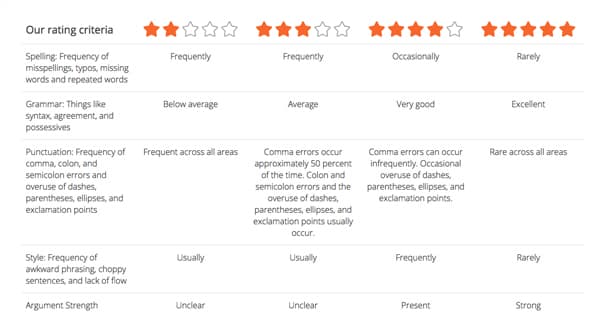Why Most Blog Articles from Textbroker Will Hurt Your SEO
Published by James Parsons • Search Engine Optimization • Posted August 10, 2018 ContentPowered.com
ContentPowered.com
We have covered Textbroker before on this site, but today I thought I’d take a bit of a more personal look at the site and the content you get from it. I’m not going to make you wait, though; my conclusion is right up front. Textbroker isn’t a very good place to buy content if you’re taking content marketing seriously.
How Textbroker Works
Textbroker is a content mill. Authors sign up and submit some portfolio pieces, which are judged by editors to place the author at a starting star level form 1 to 5. Except even that isn’t true; we’re already finding issues. A starting rating of 1 doesn’t exist; Textbroker simply rejects the writer, and with good reason. 1-star quality content is essentially Lorem Ipsum; it’s meaningless and impossible to parse. Meanwhile, a starting 5-star rating is impossible. 4 is the highest a new writer can start, and they require something like six months of activity and a tricky test to be promoted to 5.
Star rating determines how much the content is worth. Clients register and can submit assignments in one of a handful of ways.
- You can submit an assignment to the open pool under a two, three, four, or five star level, with pricing scaling accordingly. 2-star content is allowed to have grammar and even spelling mistakes. 3-star is baseline, but still often a bit janky. 4-star is the minimum for acceptable content, and 5-star is billed as “professional writing” at a comparatively exorbitant price.
- You can create a team. Teams allow you to reach out and recruit specific writers, or set up requirements for writers to see and apply to, for you to accept or reject them. You set the price, as well, giving your smaller pool of writers a benefit for being exactly what you want.
- You can create a managed team, which means Textbroker handles the management of writers, editing content, posting it, and advertising the team in their writer newsletters. This generally requires a significant investment, however.
- You can submit a direct order to a writer. Writers can set their own direct order price, so if you find a good writer and are willing to pay them more, you can negotiate it with them.
So the first problem you have as a client is the limited options for getting high quality writers. Submitting content to the open pool is a crapshoot. Anything at the 2 or 3 star level is going to be indistinguishable from spun content. The price is so low that the only writers willing to work for that price are ESL writers or those who have “techniques” (spin tools) to speed up their writing to a feasible per-hour rate.
If you want good content, you have to submit it to a carefully vetted team, to specific known good writers via direct order, or at the five-star level in the open pool. Even at the five-star level, you find a lot of writers who write competently, but not excellently. I’ll talk about that more later.
Direct orders can work fine; you can find good writers who are willing to work for a reasonable rate, but the problem is, you have to find those writers in the first place. Textbroker doesn’t make it easy to find them; there’s very little profile information or contact information, since they’re paranoid about poaching. You essentially have to submit orders to teams or to the open pool, wait until a writer you like submits finds them and submits content that is worthwhile, and then transition to direct orders.
Given how cutthroat the open pool is, it can be difficult to find those good writers. This is doubly true given that the best writers often are pulling work from multiple sites, like Writer Access, Freelancer, and Upwork, and might consistently miss when you’re posting your content.
Team orders are generally the best, except you need to spend time setting up a team. You need to come up with the requirements to vet writers, a price that will attract them, and orders they can complete to make sure they’re acceptable.
Throughout all of this, there’s the ever-present review and auto-acceptance policies in place. You submit an order and a writer picks it up. They can write and submit it essentially for free. If you don’t like it, you have to send it back for revisions. At this point, the writer can either revise the piece and resubmit it, or they can drop it and take their content elsewhere.
Now, this is where the star ratings and overviews come into play. Textbroker is supposed to consistently review submitted and purchased work, rate it with their own star level based on their standards, and adjust writer star levels based on those ratings. In practice, Textbroker is so far behind that they’ll review articles in batches of dozens or hundreds. This is fine, except the writer’s star level is based on the average of their most recent five posts.
What this means is that a writer can have written 400 extremely good posts with glowing reviews from clients, and then two that simply aren’t up to the standards of the clients or the site. Maybe they were sick or desperate for work, who knows. Textbroker rates those two posts low, and oops; the writer is now a 3-star writer. Their livelihood is essentially destroyed, Textbroker is no longer worth using, and if they don’t have a selection of good direct order clients or teams to fall back on, they’ll generally just abandon the site.
Textbroker defends this by claiming the writer can work their way back up, but three factors conspire against this. First, the star ratings are “baseline” whatever the writer’s work is rated. Even if they’re a 4-star writer, if they write 3-star assignments, those are often simply graded 3-stars. It’s exceedingly rare that a 3-star assignment is ever rated 4-stars. Second, the rarity of Textbroker overviews means it can be months before there’s even a chance to be reinstated. Third, 99% of clients will submit content to 4-star or 5-star levels, so there’s very little to actually do at the 3-star level or below.
All of this combines to make it extremely risky to try to revise an article when a client requests it. Even if the revisions are reasonable, if the client chooses to reject the post after all, the writer is instantly and irrevocably punished. It’s infinitely safer to simply drop the post.
All of this adds up to an atmosphere where you have to accept the content that comes through, or else you’ll end up having your posts repeatedly dropped.
There’s also an auto-accept policy in place. If you as a client place an order and an article is submitted to you, you have 96 hours with which to review and either accept or request revisions on the article. If you forget or you do nothing in that time period, the content is automatically accepted. Since you have to pay Textbroker when you submit the content – an escrow situation – you have to pay for it even if you hadn’t actually looked at it.
The Problem With Content
I mentioned above that there’s an issue between competence and excellence. Textbroker encourages competent writing, but they do nothing to encourage excellent writing.
Competent writing is simply writing that meets the technical standards for acceptable writing. If you take the piece and run it through Grammarly, you’ll find it adheres perfectly to the AP style guide, which is what Textbroker relies on. You won’t find typos or grammatical errors, because those are heavily punished on the site.
On the other hand, absolutely none of that is an indication of the relevance of the content. What do I mean? Let’s give an example.
First of all, let’s say you want to publish a piece of content, a simple tutorial on how to change the bit on a power drill. You know that with content marketing, your post should have at least 1,000 words in it. You also know that according to Textbroker, your content should be focused around keywords. I have issues with this, but that’s beside the point. So maybe you include keywords like “change a bit” and “power drill” to make sure the writer uses them.
Now, changing the bit on a power drill is pretty simple. All you need to do is use a chuck key to loosen the existing bit, remove it, put the new bit in, and tighten it down. Some power drills are even easier.
The topic is simple, but what isn’t simple is writing 1,000 words about it. You set the assignment at 1,000 words, so you’ll get 1,000 words. How is the writer going to take something you can explain in one sentence, and expand it into 1,000 words?
First of all, the writer is probably going to give you a couple hundred words on what a power drill is, and how it differs from hand drills. They might even give you a history on power drills, though this is more likely to happen if you set an even higher word count, like 1,500 or 2,000.
Next, the writer will explain what tools you need to change your power drill bit. They’ll probably talk about what a chuck key is. They might go off on a tangent about how to get a replacement chuck key, or about modern drill design that doesn’t need one at all.
If you’re lucky, the writer will then be able to finish up the post with a couple hundred words on how specifically to change the drill bit. If you’re not lucky, the writer might take time to talk about different kinds of bits you might want to change to, their purposes, and when not to use them. They’ll talk about the risks of not properly tightening a drill bit, and so on.
Now, because of the Textbroker atmosphere, the content will be well written on a technical level. At least, if you’re getting 4- or 5-star content, it will. The thing is, if you were Googling how to change a power drill bit, would that article be worthwhile to you?
The answer is a definitive no. 90% of the content is fluff. It’s filler, and Google knows that. That post might rank well for “history of power drills” or “what is a chuck key”, but those aren’t the keywords you wanted to target. You were trying to reach people with actionable information, and you were given the wiki page on power drills.
Excellent content will understand the goal of the post and will strive to fulfill it. Excellent content is only available at extreme prices from Textbroker, if it’s available at all.
Now, I’m not opposed to paying a high rate for excellent content. Textbroker just takes a percentage; you can find writers on freelancer hubs or through personal profiles to provide even better content for the same price, without having to pay a third party.
Valid Uses for Textbroker
If Textbroker is so poor, why does it still exist? There are two reasons, the way I see it. The first is, of course, a lot of people simply don’t know or care about the difference between competent content and excellent content. These people are reselling the content via their blog management firms or whatever, so buying cheaply from Textbroker is their ideal.
The second reason is that there are types of content that this competent approach works well at. Informational posts meant to emulate a wiki-style infodump are fine to get from Textbroker. More importantly though, small assignments of a couple hundred words at a time often come out perfectly fine. I’m talking about technical copywriting here, product descriptions and the like.
If that’s the kind of content you want to buy, more power to you. For typical blog posts, however, I really don’t think Textbroker is worth using.












I dont think so text broker effect your website SEO. Google Search Engine will take care of it.